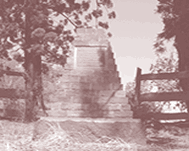|
| |
The Blacktown and Prospect areas have a long history dating back to 1788.
The first and earliest visit was on 27th April 1788, it had only been three months after first landing convicts at Farm Cove when Governor Phillip visited the area. Governor Phillip wrote a few days later to the Home Secretary, Lord Sydney. Here is an extract of Phillip's report:
"I set off the 22nd of April, with 6 days provisions. We were eleven officers and men, and landed at the head of the harbour...We proceeded westward, finding the country in general as fine as any we ever saw, the trees growing 20 to 40 feet from each other...The country through which we past was mostly level, or only rising in small hills, which gave it a pleasing and picturesque appearance. The fifth day we got to a rising ground...The country was so beautiful that I called the hill Bellevue..."
The Surgeon General to the First Fleet and Settlement at Port Jackson John White's "Journal of a Voyage to New South Wales" (1790) where he stated:
"His Excellency (Governor Phillip) gave it the name of Belle Veue...From the top of this hill we saw a chain of hills or mountains which appeared to be thirty or forty miles distant, running in a north and south direction. The northernmost being conspicuously higher than any of the rest, the governor called it Richmond Hill; the next or those in the centre Lansdown Hills, and those to the southward, which are by much the lowest, Carmarthen Hills. In a valley below Belle Veue we saw a fire, and by it found some chewed root of a saline taste, which shewed (sic) that the natives had recently been there"
Within a year it was referred to as Prospect Hill and became a landmark in Australia's third settlement, after Sydney Cove and Parramatta, an area known then as Toon-gab-be (Toongabbie). The area was first farmed four miles west of Parramatta, north/south along Toongabbie Road and was granted to among others John Nichols, William Butler and George Lisk.
Later in 1789, that Captain Watkin Tench visited Prospect Hill. Phillip was to visit at that time as well, but was unfortunately too ill to travel.
Prospect Hill was formed by an intrusion of dolerites rock into Ashfield Shale, the intrusive rock covers an area of approx 700 acres. Prospect Hill's maximum height is 200 feet above the surrounding countryside and it is approx 2000 metres above sea level.
Prospect Reservoir, opened in 1880, the now flooded area adjacent, was once the lush grazing property of William Lawson. The Reservoir in conjunction with Woronora Dam supplied all of Sydney's water until 1960. William Lawson accompanied by Blaxland, Wentworth and acting under the request of Governor Lachlan Macquarie found the first suitable way for oxen to cross over the Blue Mountains to the lush valleys beyond.
Blacktown was originally named Black Town, many indigenous Australians were relocated there when the School for Aboriginal Children (Native Institution) was relocated from Parramatta, after training programs had failed.
Blacktown is now a multicultural city and the demands of property development in the area, both industrial and domestic, continues to put pressure on the historical aspects of the region.
Many of the historical buildings, like the original sandstone Blacktown Station, William Lawson's house Veteran Hall, Colonel John Campbell's Bungaribee House, the Robin Hood Hotel and Rooty Hill's Government Stock Farm have been lost. All victims of progress.
However many links to the lost past remain, the tree-lined road to Prospect Reservoir from Reservoir Road, once William Lawson's driveway. It led to Veteran Hall, built in 1820's, unfortunately demolished in 1929 by the Metropolitan Water, Sewerage and Drainage Board.
Contrary to some statements made over the years it did not need to be demolished as it was well above the waterline. In fact, it was used during construction of Prospect Reservoir by the MWS&DB as a supervisors' office.
There is a cairn marking the spot where Veteran Hall stood, down what should be called 'Lawsons Drive', now the entrance drive to Prospect Reservoir.
William
Lawson made the first founding donation of 100 pounds towards the building of the local St Bartholomews church, built in the 1840's. The church stills stands today, although it was relocated from its original site as Prospect Reservoir was constructed.
Grey Stanes, a magnificent building, featuring immaculate wrought iron verandah railings, built in the 1830's by William Lawson for his son. It was located on Prospect Hill. It was unfortunately demolished in the 1940's after extensive friendly damage during World War Two, caused reportedly by soldiers camped on Prospect Hill. The Grey Stanes gates can still be seen on Greystanes Road, Greystanes.
In the interests of our cultural historical identity it is imperative that which remains of the local history of the Blacktown area is preserved.
|
|



